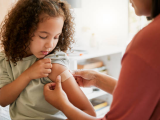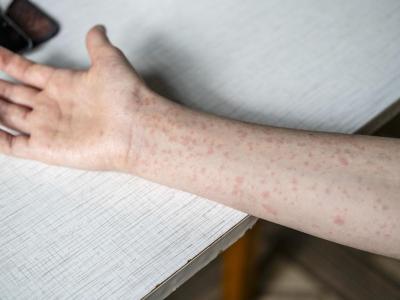Sep 18, 2009 (CIDRAP News) – The first wave of H1N1 vaccine will probably consist of 3.4 million doses of MedImmune's nasal-spray product and is likely to reach providers the first week in October, federal health officials said today.
At the same time, officials said the pandemic virus is now circulating widely in 21 states, 10 more than a week ago, and the number of patients going to clinics and hospitals with flu-like illness is about twice what is normal for this time of year.
Health and Human Services Secretary Kathleen Sebelius said on Sep 13 that the first doses of vaccine could become available the first week in October, but today marked the first time officials gave a specific number. Previously the general expectation was that the first doses wouldn't be available until mid October.
"We actually anticipate being able to start receiving orders for the vaccine by early October, and actually vaccine going out and being distributed by providers by the first week of October," Dr. Jay Butler, head of the Centers for Disease Control and Prevention (CDC) H1N1 Vaccine Task Force, said at a news briefing today.
"Initially we anticipate that about 3.4 million doses of vaccine will be available," he said. "Additional doses may be available as well, but 3.4 million is the hard number we have now. All of that is the nasal spray vaccine."
The live attenuated vaccine from MedImmune is indicated for children and adults aged 2 through 49, under the approval granted by the Food and Drug Administration (FDA) on Sep 15.
The vaccine will be allocated to states in proportion to population. Under a centralized distribution system set up by the CDC, vaccination providers request doses from their state health department. States will screen the requests and then place orders with the CDC, which will transmit orders to McKesson Corp., the company handling the distribution.
Local decisions important
While the doses are recommended first for high-risk groups, such as pregnant women, healthcare workers, children, and adults with certain chronic health conditions, who actually gets the first doses will depend on local decisions and circumstances, Butler said.
"In any given location the availability of the vaccine may actually vary. So oftentimes that decision of who is actually administered the vaccine may ultimately be decided by the provider and the patient," he said.
He said some states have identified maternity hospitals where they may want to send the first doses of vaccine, though that would require an injectable rather than the nasal-spray vaccine. States may also try to steer early doses to healthcare workers and to people who will be living with babies under 6 months old, he said.
Vaccine will be shipped from four sites around the country to facilitate rapid distribution, Butler said, but added that he didn't know the locations.
The distribution system is an expanded version of what the CDC uses for its Vaccines for Children program, which involves about 40,000 providers. The agency expects about 90,000 sites to participate in the campaign.
Not all of those 90,000 will be individual vaccination providers, Butler said today. Some may be retail chains that may redistribute vaccine to their outlets.
Regarding vaccine dosage, the expectation is that children under age 10 will need two doses, while one dose will suffice for older children and adults, Butler noted today.
(The age recommendations differ slightly among the three vaccines the FDA has approved for use in children. For MedImmune the indication is two doses for children 2 through 9 years old; for Novartis it is two doses for ages 4 through 8, and for Sanofi Pasteur, two doses for ages 6 months through 8 years.)
The CDC has been predicting that about 45 million to 50 million doses of vaccine will become available in mid October, followed by about 20 million a week after that, reaching a total of 195 million in December. Butler reaffirmed that forecast today.
At today's briefing, Dr. Dan Jernigan, deputy director of the CDC Influenza Division, emphasized that the extent of flu activity is very unusual for this time of year, with some flu in every state and widespread cases in 21 states.
From monitoring at outpatient clinics and emergency rooms around the country, "What we're finding is there is an increased amount of folks coming into clinics with influenza; it's about twice at least what we would expect at this time of year," he said.
"We expect to see a whole lot more illness in coming weeks and throughout the flu season," Jernigan said.
As for hospital cases, he said, "What we see so far is there is some increase in the rate of hospitalization for children and young adults, but it's not up at the same levels we see during seasonal flus."
Jernigan cited "considerable" flu activity in the Southeast, where schools opened earlier than elsewhere, but did not mention any other regional hot spots.
The vast majority of viruses in circulation are the novel H1N1, and they remain well matched to the vaccine that's on its way, he said.
In response to a question, Butler said people who have had a recent flu-like illness should still get the H1N1 vaccine if they are in a target group unless they had a confirmed case of H1N1.
"People who have actually been infected with the 2009 H1N1 virus likely do have some immunity," he said. But most cases were not lab-confirmed, and other flu strains, as well as other respiratory viruses, have circulated during the epidemic, he noted.
Global picture varies
In other developments, the World Health Organization (WHO) in its weekly update reported varying levels of H1N1 activity across the globe.
The United States is seeing increased flu activity, most notably in the South, Southeast, and Northeast, whereas activity remains low in Canada, the WHO said. Europe and Central Asia also have low activity overall, but France is seeing increases, and localized activity is reported in several European countries and Israel.
Flu activity in Japan is holding above the seasonal epidemic threshold, the WHO said. Meanwhile, much of South and Southeast Asia has regional or widespread outbreaks, with cases increasing particularly in India and Bangladesh. Regional to widespread activity also continues to be the story in tropical parts of Central and South America.
In temperate parts of the Southern Hemisphere, flu continues to wane or has sunk to the seasonal baseline in most countries, the WHO said.
Twenty-six cases of oseltamivir-resistant H1N1 flu have been identified globally, the agency said. Another 10,000 isolates have been tested and found sensitive to the antiviral.
See also:
CDC's flu update for the week that ended Sept 12
http://www.cdc.gov/flu/weekly/
Sep 18 WHO update
http://www.who.int/csr/don/2009_09_18/en/index.html


















